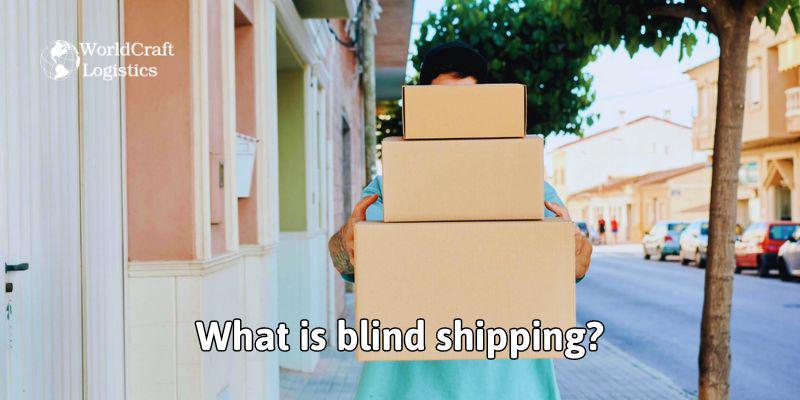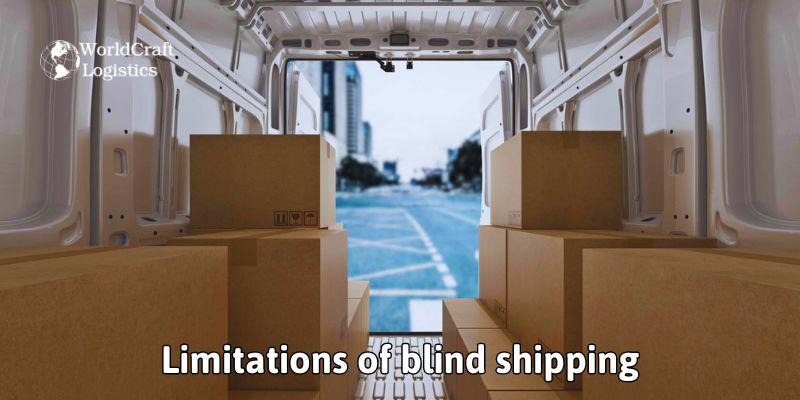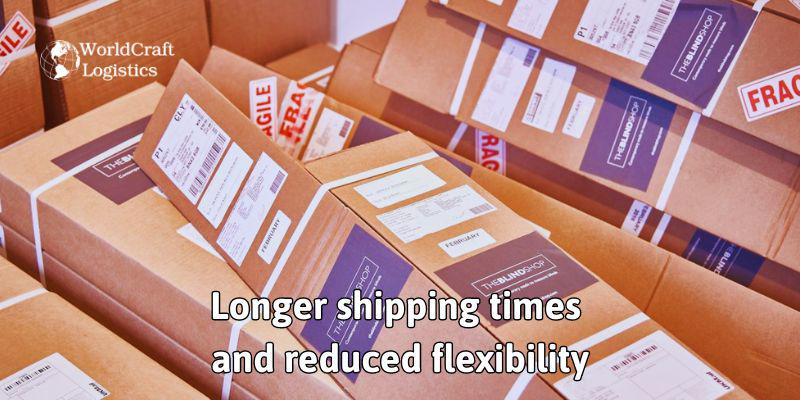
Starting June 1st, 2023 Our warehouse fee will be $0.65/cubic foot per month
In effort to lower the warehouse storage fee during inflation, we have went narrow aisle racking.This construction took us four months but the project is finally completed. With narrow aisle racking, we are able to drop storage by 24%.We as partners will go through this inflation together.
03/29/2024
Blind shipping is a method that safeguards your brand reputation, enhances efficiency, and provides a competitive edge.
At Worldcraft Logistics, we've assisted numerous ecommerce ventures in utilizing blind shipping to enhance their customer satisfaction and profitability. But what exactly is blind shipping?
In this article, we'll clarify what blind shipment entails, outline its benefits, and offer guidance on initiating the process.

Blind shipping is a shipping approach where the supplier's details are hidden from the recipient. Invoices and packaging show only the seller's information and branding, a practice known as a blind bill of lading. Typically, this includes basic details like the product description, quantity, weight, and destination address.
Here's how blind shipping works across different fulfillment methods:
✍️ Traditional fulfillment: Inventory is stored at a fulfillment center or third-party logistics company (3PL). When an order is placed, the 3PL ships the product with the seller's information, concealing the supplier's identity.
✍️ Dropshipping: Orders from the online store are forwarded to the dropshipping supplier, who ships the product directly to the customer under the seller's branding.
✍️ Freight forwarding: Freight forwarding companies specialize in international shipping, managing customs regulations, tariffs, and other complexities. They can help ensure blind shipments across borders.
In each scenario, customers perceive the product as coming directly from the seller, enhancing brand credibility and the overall customer experience.
Consider this hypothetical example: A technology company sells industrial electronic equipment but doesn't want customers to receive shipments with the supplier's details. To address this, they collaborate with a fulfillment center for blind shipping.
Now, orders are shipped directly from the fulfillment center, displaying only the technology company's address. This reinforces the perception that the technology company manages the entire fulfillment process, maintaining its brand integrity and discouraging customers from contacting the supplier.
Blind shipments enable the technology company to concentrate on design, sales, and marketing, while the fulfillment center handles inventory management, shipping, and returns.

Blind shipments provide several advantages for third-party sellers and businesses of all sizes. Here's a look at these benefits and how they might suit your supply chain needs:
✔️ Protects Supplier Relationships: Concealing supplier information prevents customers from bypassing you and contacting the source directly. This preserves your supply chain and the investment in your partnerships.
✔️ Maintains Competitiveness: Blind shipping makes it challenging for competitors to identify and potentially poach your suppliers, giving you a competitive edge. It also complicates price comparisons for customers, fostering loyalty to your brand.
✔️ Enhances Brand Experience: You have full control over the customer unboxing experience with blind shipping. Consistent branding, custom packaging inserts, and reliable shipping contribute to a memorable brand impression.
✔️ Streamlines Operations: Blind shipping is particularly beneficial for drop-shippers as it eliminates the need to manage inventory, reducing warehousing and shipping expenses.
✔️ Expands Customer Options: Blind shipping allows you to offer products or shipping options that might not be feasible if you were handling all shipping yourself, providing more choices for your customers.
Our other articles:
👉 The 5 BIGGEST differences between FTL and LTL shipping
👉 What is palletized shipping? Guide for shipments transported by pallets
👉 Shipping surcharges: Understanding the mean & types of fees

Blind shipping undoubtedly provides compelling advantages, yet it's equally essential to acknowledge and address potential challenges.
Maintaining consistent quality can be a concern in blind shipping scenarios, as you don't directly handle your products. To mitigate this risk, thorough supplier vetting and regular quality checks are imperative, particularly when utilizing a fulfillment center.
It's important to note that not all fulfillment centers provide blind shipping services. Therefore, it's crucial to select a partner with a demonstrated track record in blind shipments and a comprehensive understanding of the process. Additionally, inquire about their inspection procedures and protocols for handling defective products to ensure that quality standards are upheld throughout the shipping process.

Depending on an unsuitable third-party logistics company can lead to extended shipping times, particularly if suppliers and fulfillment centers are not strategically located.
It's crucial to verify that your chosen fulfillment center maintains strategically positioned warehouse facilities to guarantee prompt and efficient shipping. This ensures that products can be quickly dispatched to customers, minimizing shipping delays and enhancing overall customer satisfaction.
Addressing customer concerns or issues with products or shipments in blind shipping scenarios may involve intricate communication, necessitating coordination between you, your supplier, and the customer. Establishing an efficient blind shipment return process can help mitigate potential frustrations for all parties involved.
In essence, it's crucial to maintain clear and open lines of communication among you, your supplier, and the fulfillment center to facilitate seamless blind shipment operations. This ensures that any challenges or inquiries are promptly addressed, contributing to a positive customer experience and overall operational efficiency.

Implementing blind shipping successfully requires careful planning and collaboration with your fulfillment partner. Here are the key steps:
Before initiating blind shipping, packaging preparation is essential. While some fulfillment companies may handle this task, it's crucial to inquire beforehand.
🔸 Remove Supplier Branding: Ensure all products and original packaging are devoid of any supplier branding or identifying information.
🔸 Custom Packaging (Optional): Consider incorporating branded boxes, tape, or inserts to elevate the unboxing experience for customers.
🔸 Inventory Labeling: Collaborate with your fulfillment partner to establish a precise labeling system for efficient product tracking and management.
Establishing a robust return and exchange policy is essential for your business:
🔸 Set Clear Policy: Determine whether returns will be managed internally or directed to your supplier or fulfillment center. Clearly communicate this policy to customers.
🔸 Ensure Speedy Returns: Collaborate with your fulfillment partner to streamline the return process, ensuring prompt and efficient handling of returns.
To ensure the success of blind shipping, diligent monitoring is essential, encompassing delivery times and customer feedback.
🔸 Start Small: Initiate with a limited number of products to pilot the system and resolve any initial challenges effectively.
🔸 Schedule Check-ins: Maintain regular communication with your fulfillment partner, particularly during the initial phases, to guarantee seamless operations. Monitor delivery schedules closely.
🔸 Customer Feedback: Keep track of customer reviews and feedback to detect and resolve any emerging issues promptly. Adjust strategies based on customer responses for continuous improvement.
While blind shipping presents numerous advantages, it's imperative to consider potential legal implications, particularly regarding the following areas:
🔸 Product Liability: Even if you don't manufacture a product directly, you may still carry liability if it causes harm to a customer. Thorough supplier vetting, quality control measures, and product liability insurance are crucial for mitigating this risk.
🔸 Intellectual Property Agreements: If utilizing blind shipping for customized or rebranded products, ensure you have appropriate agreements with your suppliers to prevent potential intellectual property disputes.
Additionally, it's advisable to consider the following:
➡️ Accurate Documentation: While your branding should be prominent, ensure customs paperwork and shipping labels accurately identify the actual shipper (often your supplier or fulfillment center) to comply with import and export regulations.
➡️ Product Safety and Regulations: You remain responsible for ensuring products meet safety standards and industry regulations. Thoroughly vet your suppliers to ensure compliance.
➡️ Country-Specific Restrictions: Research regulations for your target markets, as certain products may be restricted or subject to additional duties when shipping internationally.
It's important to note that laws and regulations regarding product liability and intellectual property vary by jurisdiction. Consulting with a legal professional is strongly recommended to address specific legal considerations relevant to your business, products, and target markets.
If you have concerns about a particular product or market, seeking advice from a legal professional can provide clarity and guidance.
🔸 Cost Analysis: Calculate all blind shipping expenses, including product, packaging, and fulfillment costs.
🔸 Markup Calculation: Determine a suitable markup to cover expenses and ensure profitability.
🔸 Volume Discounts: Offer discounts for bulk orders to incentivize higher order volume.
🔸 Value-Based Pricing: Highlight blind shipping benefits and adjust prices accordingly.
🔸 Transparency: Clearly communicate pricing and any additional fees associated with blind shipping.
🔸 Negotiation: Be open to negotiating prices based on partner needs and circumstances.
🔸 Regular Review: Periodically review and adjust pricing based on changes in costs and market conditions.

When selecting a blind shipping partner, several key considerations should be taken into account:

By meticulously evaluating these factors, you can identify a blind shipping partner that streamlines your fulfillment process, bolsters your brand reputation, and delivers a positive customer experience.
Double blind shipment advances the concept of blind shipping by concealing the identities of both the shipper and receiver. This heightened privacy measure is often utilized in industries where discretion is paramount, such as pharmaceuticals or sensitive intellectual property sectors.
Implementing double blind shipping necessitates specialized logistics providers and isn't advisable for standard commerce scenarios.
Both blind shipping and dropshipping protect your supplier's identity from the customer. The main distinction lies in inventory ownership. In dropshipping, you never physically handle the products, whereas with blind shipping, you may either store inventory with a fulfillment partner or have the supplier ship directly to the center for fulfillment.
The necessary documents for blind shipping operations typically include:
These documents may vary based on shipment requirements and confidentiality agreements.
SEO
Digital Marketing/SEO Specialist
Simon Mang is an SEO and Digital Marketing expert at Wordcraft Logistics. With many years of experience in the field of digital marketing, he has shaped and built strategies to effectively promote Wordcraft Logistics' online presence. With a deep understanding of the logistics industry, I have shared more than 500 specialized articles on many different topics.

Education
01/05/2025

Education
02/18/2025

Education
01/01/2024

Education
08/28/2024

Education
11/13/2023